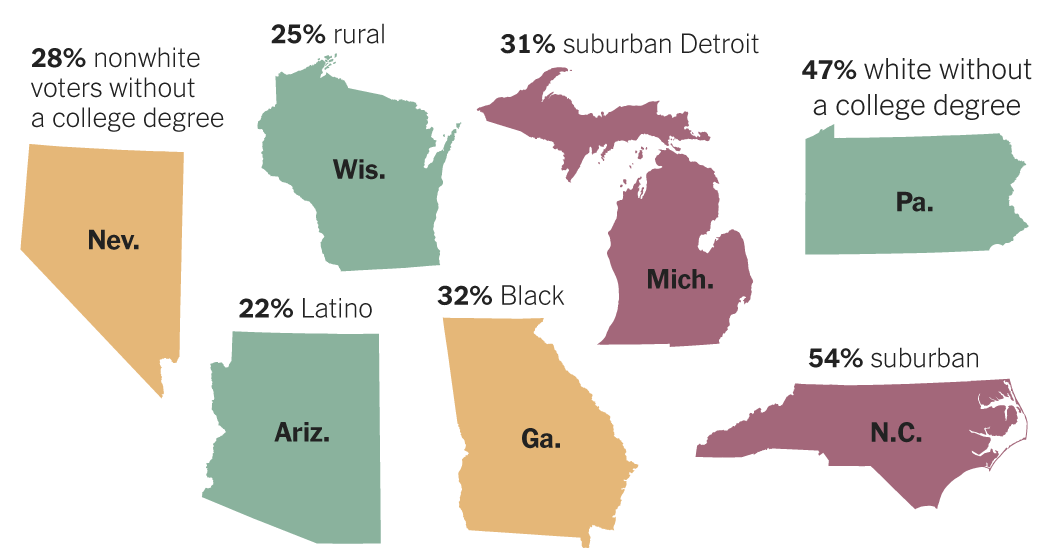Which battleground voters could influence the election?

It’s no secret that Americans’ political sentiments follow lines of race and ethnicity, education and age. But what makes presidential elections so competitive is the fact that these demographic groups often balance each other out.
Voters in key states in 2020
In 2024, this delicate balance is crucial for understanding the seven battleground states where the presidential race is closest, according to the polls. In the last election, several of these states were decided by fewer than 40,000 votes. Since then, they have collectively added about 1.3 million potential voters, and the smallest shifts in sentiment or turnout among certain groups could be enough to change the outcome of this election.
To better understand the demographic forces at play in the battlegrounds, The New York Times conducted a detailed review of the 2020 election, comparing precinct-level results with census data to estimate who voted and how they voted. We examined race and ethnicity, age, education and geography to identify trends and key groups in each state. (Gender is another growing factor in partisanship, but was not part of this analysis.)
Result 2020: Biden won by 10,000 votes
Main groups: Latino voters, young voters
The 2020 electorate
3.4 million people voted
1.7 million people did not vote
What to watch President Biden’s winning coalition relied heavily on Latino voters, who made up nearly a quarter of those who voted in 2020, a figure likely to rise in this election. But while Latino voters in the state generally favor Democrats, no group is a monolith.
Experts say Latinos have a weaker connection to the party than other non-white groups and could be persuaded to change their vote. Moreover, a significant portion of this group consists of U.S.-born, young Latinos who will be voting for the first time, and their sentiment is less predictable. Recent surveys have shown that former President Donald J. Trump is making inroads with young people and voters of color.
Trump’s strongest support in 2020 came from white voters aged 35 and older. This group accounted for half of the votes cast, in part because of the large number of white retirees in the state.
There are potentially more votes to be won for the Democrats. In 2020, more votes were cast for the Democratic Senate nominee than for Mr. Biden. “The voters who voted for Mark Kelly but decided not to vote for Biden or Trump could have determined the outcome of the race,” said Samara Klara, a political science professor at the University of Arizona.
Result 2020: Biden won by 12,000 votes
Main groups: Black voters, white voters with college degrees
The 2020 electorate
5 million people voted
2.5 million people did not vote
What to watch Democrats in Georgia have long been guided by the “30/30 rule,” a term popularized by University of Georgia political scientist Charles S. Bullock III. It says that for Democrats to win, black voters must make up 30 percent of all voters and at least 30 percent of white voters must vote Democratic.
Black voters, who cast nearly a third of the votes in 2020, overwhelmingly favored Biden — by nearly 90 percent. But that reliable base of support appeared to be waning earlier this year, and it’s a group that experts say should energize and excite Vice President Kamala Harris. About 850,000 Black Georgia residents did not vote in 2020.
“If turnout among black voters is anemic, that spells doom for the Democratic ticket,” said Andra Gillespie, a professor of political science at Emory University.
Voters in Georgia, by race and education
Both parties will also try to appeal to a growing share of white voters with bachelor’s degrees, a group whose votes in 2020 were almost evenly split between Mr. Biden and Mr. Trump.
Result 2020: Biden won by 154,000 votes
Main groups: Suburban voters, black voters, Arab-American voters
The 2020 electorate
5.5 million people voted
2 million people did not vote
What to watch In 2020, Mr. Biden won Michigan handily — at least by the standards of a battleground state.
But Trump performed very well among white residents of suburban and rural communities, who made up nearly two-thirds of voters in the 2020 election.
Michigan voters by geography
Democrats’ strong performance among nonwhite voters and in Detroit’s suburbs helped erase Republicans’ lead in the suburbs around smaller cities in 2020. But while Black voters overwhelmingly supported Mr. Biden, they were a relatively small group — just 14 percent of those voters. who cast ballots. And experts say black support for Democrats in Michigan could be declining.
“There is certainly an attitude that they are not represented, compared to their population and their outsized role in the Democratic party,” said Matt Grossmann, a political science professor at Michigan State University. He pointed to Detroit, a majority-black city with no black representation in Congress. “The feeling is: how much attention are you paying to us? And to what extent do you take us for granted?”
Disillusionment among the estimated three percent of Michigan voters who are Muslim and Arab-American — a traditionally strong Democratic constituency — could also make a difference this year. Many of these voters have expressed anger and frustration over the Biden administration’s support for Israel in the Gaza war, and some have said they may choose to sit out this election or cast their votes in favor a third party candidate.
Result 2020: Biden won by 34,000 votes
Main groups: Non-white voters, voters without a college degree
The 2020 electorate
1.4 million people voted
783,000 people did not vote
What to watch Nationally, education is a major political divide, with more educated voters much more likely to support the Democratic Party and less educated voters favoring the Republicans. But Nevada is the main exception to this rule: Democrats have won the past four elections there, despite the state having a relatively low share of college-educated voters.
That’s because education divides most white voters, and many of Nevada’s less educated voters are not white. Mr. Biden won half the votes among voters without a four-year degree in Nevada, atypical for the nation as a whole.
Nevada voters by race and education
In recent years, inflation has hurt working-class voters, and concerns about the economy could make it easier for the Trump campaign to capitalize on the Democratic advantage with working-class voters of color.
“Nevada is a bit of a different animal,” said David Damore, a political science professor at the University of Nevada, Las Vegas, pointing to the state’s low voter turnout, high diversity and more transient population. “All this means there are many potential untapped voters who can be mobilized.”
Result 2020: Trump won by 74,000 votes
Main groups: Rural voters, suburban voters
The 2020 electorate
5.5 million people voted
2.3 million people did not vote
What to watch In 2020, North Carolina gave Mr. Trump the narrowest lead of any state he won. Rural voters, who accounted for nearly a fifth of the total, helped Trump achieve his victory.
North Carolina voters by geography
But North Carolina also has many small towns with a strong partisan divide between city dwellers, who favor Democrats, and suburbanites, who favor Republicans.
If Democrats want to flip the state, they need to lose fewer votes in rural areas and increase turnout in smaller cities such as Greensboro and Asheville, said Chris Cooper, a political science professor at Western Carolina University.
“If we see a marginal movement away from Trump in rural areas, that is very important,” he said. “These places are still shown in red on the map, but those differences can mean the difference between winning and losing.”
Result 2020: Biden won by 82,000 votes
Main groups: Voters without a four-year college degree, suburban voters
The 2020 electorate
6.9 million people voted
Three million people did not vote
What to watch As in other states, education plays a major role in Pennsylvania’s partisan divide. White voters without a bachelor’s degree made up nearly half of the total, and they favored Mr. Trump three-to-one in 2020. Still, that wasn’t enough for him to overcome the coalition of white voters with college degrees and voters of color. which gave Mr. Biden a victory.
The other big factor is geography.
Pennsylvania voters by geography
Trump dominated the state’s rural areas and small towns, as well as the suburbs of Pittsburgh. But Biden had a strong presence in Pennsylvania cities and the Philadelphia suburbs, areas that accounted for more than 40 percent of the vote in 2020.
Result 2020: Biden won by 21,000 votes
Main groups: Rural voters, young voters
The 2020 electorate
3.3 million people voted
1.1 million people did not vote
Wisconsin saw a similar geographic divide among voters. Most of Trump’s support came from the state’s thousand-plus small towns and the Milwaukee suburbs.
But the fastest-growing part of the state is an area increasingly in Democrats’ favor: the suburbs of Madison, home to the main campus of the University of Wisconsin.
Wisconsin voters by geography
In 2020, turnout in Dane County, which includes Madison, was 89 percent.
“It’s one of the highest voter turnout counties in the country,” said Charles Franklin, the director of the Marquette Law School Survey. “The question for Democrats here is: Is it even possible to squeeze more votes out of Dane County?”




